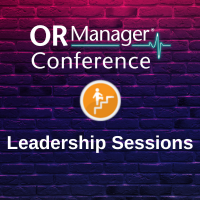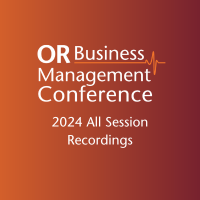Description
This package includes Staffing session recordings compiled from breakout and general sessions at the 2022 OR Business Management Conference. After viewing the content, complete a brief quiz and evaluation to earn 6 CEs.
Presentations include:
- The Goldilocks of Staffing Models: How to Assess Staffing Needs for Current or Future Volume
- How Will We Staff the Economic Engine of the Hospital?
- Perioperative Preceptor Development: Journey of a STAR
- Staffing in a Post-COVID Labor Market
- Keynote: Turn Your Workplace Into a WOWplace – 5 Rules for Leading Your OR Suite to Success
- Leadership Roundtable Panel
Learn more about the sessions below:
The Goldilocks of Staffing Models: How to Assess Staffing Needs for Current or Future Volume
Ensuring your ORs are efficiently staffed but not too lean is always a challenge. Our team developed a staffing model tool that has allowed the department to accurately assess the number of staff needed at any given time of day, arrange shifts to cover those times, and successfully demonstrate the need for nursing and hospital leadership to gain support.
There are four key steps:1) Understand the staffing needs by case type, break requirements.2) Collect historic case data and model planned growth.3) Optimize the model for consistency of shifts and shift duration.4) Once validated with key stakeholders, socialize with staff and leadership for support.
The process begins with an understanding of what is needed to support casework. We then analyze historic trends to identify specificity by day. The next step is to collect and organize case data and any projected growth. This includes number of cases by day of week, average case duration, and turnaround times. Information relative to paid time off for the staff, break frequency and duration, and other scheduling data will also need to be collected. For step three, the model marries both sets of information previously collected to identify the number of staff needed by hour for each weekday. Once shifts are overlaid, break relief is measured and adjusted. Finally, the model optimizes by shift mix of eights, tens, and twelves to minimize waste.
The last step of the assessment and implementation is socializing the information. Often, the analysis will display times when the current staffing may not meet the ideal needs of the unit and it is easy to visualize this change. This is particularly useful when current staff may be asked to change their start times or shift duration to match department needs. It may be necessary to add staff; the model, with clear steps and targets, makes it easy to see where those needs are.
Learning Objectives:
- Describe key steps to create and implement a staffing model.
- Describe how to gather the needed information and package it all together.
- Identify the importance of socializing the results and leveraging the model to gain staff buy-in for change and leadership support.
How Will We Staff the Economic Engine of the Hospital?
The exact number of American perioperative nurses is not known with any certainty. Nor is there reliable information on the demographic makeup of these nurses. There are reports of staffing shortages in the specialty which have been exacerbated by the COVID pandemic. The lack of meaningful perioperative nursing content in pre-licensure education courses makes recruiting problematic for the profession. The operating room is the economic engine of the hospital but that engine must be staffed by perioperative nurses. Researchers from the Competency and Credentialing Institute will present findings from 2021-2022 research study which sought to gather detailed demographic information on the specialty. Workforce planning and recruiting into the complex specialty of perioperative nursing is difficult and recent OR Manager surveys reinforce the data on staffing shortfalls. The information presented in this session will clarify the makeup of the profession and will also serve to guide recruiting and retention efforts for employers. Attendees will gain a better understanding of the makeup of the perioperative nursing specialty and the unique recruiting challenges inherent to staffing an operating room.
Learning Objectives:
- Estimate the total number of American perioperative nurses.
- Describe one source of demographic information for perioperative nurses.
- Identify one challenge to recruiting nurses into the perioperative specialty.
Perioperative Preceptor Development: Journey of a STAR
Preceptors need guidance and techniques in transferring knowledge and skills when orientating. The perioperative STAR preceptor development program aims to address this need using the STAR technique. The program launched in 2020 at the height of the pandemic. It continued as a month-to-month class; one year later in August 2021, the program had trained 61 RN preceptors. Each of the five different OR campuses as well as the preoperative and PACU units of these campuses have been represented. The ratio of 321 perioperative RNs to 61 RN preceptors account for 19% of trained preceptors who have been taught the concepts of adult learning. In the span of one year, 17% improvement of preceptor availability is observed. Further evaluation would determine perceptions of impact of the use of adult learning strategies during orientation. Retention improvement has been obvious and job satisfaction levels are improving.
Learning Objectives:
- Discuss the four major roles of the Perioperative STAR preceptor.
- Define the four major roles of a STAR preceptor.
- Identify the four stages of the Adult Learning Cycle.
Staffing in a Post-COVID Labor Market
In this post-COVID labor market, healthcare employers need to have the ability to aggressively compete for qualified team members. According to the Bureau of Labor Statistics as of September 2021, the healthcare sector ranked one of the highest in job separations leaving 42% of the open positions that were reported unfilled. Whether your perioperative department is part of a large hospital system or an independent facility, it is important to develop strategies to create interest that will not only attract applicants to your organization, but will also entice them to commit to working with you after the interview. It is also important to recognize that some recruitment methods can have a negative effect on an organization’s most important resources – current and tenured team members.
We will explore current methods being used to recruit new talent into healthcare organizations. We will also discuss strategies to ensure your organization is competitive in the job market, including mitigating effects of recruiting incentives on your current team.
Learning Objectives:
- Identify at least three staff recruitment strategies currently being used in the healthcare environment.
- Identify key points to discuss during the interview process that can set you apart from other facilities.
- Discuss strategies to mitigate the negative effects of strong recruitment methods on staff retention.
Keynote: Turn Your Workplace Into a WOWplace – 5 Rules for Leading Your OR Suite to Success
The mindsets and concepts of great leadership have been taught forever. In fact, we all know what to do; the difficulty comes in finding ways to do it consistently, even in the face of disengagement and business and personal pressures. An added challenge is that we all have “blind spots” when it comes to our own thoughts and behaviors that are hard for us to recognize and even harder for others to tell us. In this entertaining and enlightening program, Sandy shares stories and insights that help leaders identify the daily actions and behaviors they can do to inspire employee engagement and contribution. She will share a successful formula for creating cultural consistency in the midst of human inconsistency and allowing everyone to respond respectfully and compassionately when human mishaps occur so everyone can get back to the business of caring for patients ASAP.
Leadership Roundtable Panel
Hear directly from members of the OR Business Management Program Committee and their perspective on the business of managing the surgical suite. Ask your burning questions and get advice on overcoming challenges with staffing, scheduling and operating on razor thin margins.


